Putting Food By for a Sustainable Harvest
Air Date: Week of October 1, 2021
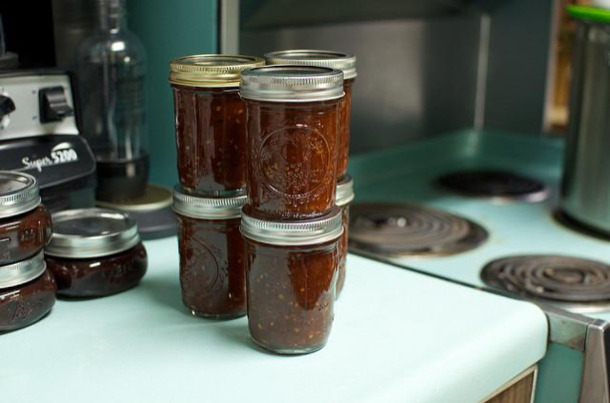
Tomato jam is an all-time favorite recipe from readers of Food in Jars. It’s a sophisticated ketchup substitute that can be used in anything from a cheese platter to a burger. (Photo: Courtesy of Food in Jars)
About 30-40% of the food produced in the United States is wasted, even as tens of millions of Americans are food insecure. As the harvest season picks up, Marisa McClellan, a food writer and author of the book Food in Jars, joins Host Bobby Bascomb to discuss preservation tips and tricks for keeping the bounty and preventing fresh produce from ending up in landfills.
Transcript
CURWOOD: So, Bobby before the break you talked with Michael Weishan about your gardening setbacks and successes. It’s the end of the season, so what are you planning to do with all your excess produce?
BASCOMB: Well, I’ve been freezing a lot of tomatoes and we actually made apple cider last week with most of our apples. You know the harvest season, right now, is really a sweet spot when many gardeners and farmer’s market still have summer produce like tomatoes and cucumbers but fall pumpkins and apples are also abundant.
CURWOOD: Right, for my grandmother, like so many of her generation, this was a time to can, pickle, and dry food to get through the long cold days of winter ahead.
BASCOMB: For sure, today, though, we really waste a lot of food in this country. Between 30 and 40 percent of all the food produced in the US is wasted. And that adds up to a huge contribution to greenhouse gas emissions, roughly the equivalent of 32 million cars on the road.
CURWOOD: Oh yeah and yet people still go hungry.
BASCOMB: Right. So, to get some tips on how to avoid some waste and preserve the food of the harvest season I am gonna bring in Marisa McClellan now. She’s a food writer, blogger, and author of the book, Food in Jars. Marisa McClellan, welcome to Living on Earth!
McCLELLAN: Thank you so much, I'm delighted to be here.
BASCOMB: So some of our listeners may be gardeners, but let's say you don't have a garden of your own, what are the best places to get local food this time of year for preserving?
McCLELLAN: Well, some of the very best places to go are your local farmers markets or farm stands. I love to go to the farmers market that happens in my neighborhood once a week. And I've been going there for almost 20 years now. And so I have made lots of friends with my farmers and they like to hook me up with seconds and good deals of produce, so it works out well.
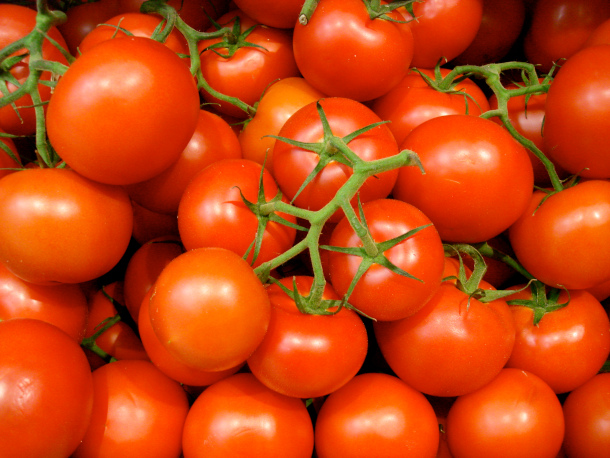
At the start of the fall season tomatoes are abundant in markets so it's the perfect time to preserve sauces, broths and purees. (Photo: Missy, Flickr, CC BY-NC-ND 2.0)
BASCOMB: Oh, do you have to go and you know, glean the apples on the ground at the end of the apple season, that sort of thing.
McCLELLAN: I do that sometimes. But I have gotten to know so many people that I can often just email or text and say- hey, I'm open, you know, whatever you've got in terms of seconds, if you've got 15 or 20 pounds of something you're looking to move, I'm your girl. And they will bring me boxes at the farmers market and we'll do a little behind the table deal and I'll go home with 20 pounds of apples or peaches or pears or whatever you know they have that needs to be used.
BASCOMB: I believe you live in a high rise in a city you're not on a farm in the middle of nowhere and you're still pulling this off.
McCLELLAN: It's true I live on the 20th floor of a high rise in downtown Philadelphia. But you know sometimes it's actually easier to be a caner who doesn't garden because it means that I have all my time for food preservation and can really work with my local farmers and growers and get the best of what they grew, support them in their work and I feel like everybody wins.
BASCOMB: You know, I remember going to my grandmother's house when I was a little kid and she'd have me go down to the basement and get potatoes for dinner. They were stored in this this huge wooden bin, it seemed huge to me at the time anyway, full of sawdust and it was just a simple way to keep potatoes through the winter. Are there other ways to keep fresh food fresh, you know for the long haul?
McCLELLAN: Well, these days that is a certainly a tried-and-true technique of sort of root cellaring things you know, potatoes, carrots, apples, winter squashes all do really well in sort of those cool, slightly moist environments. And then as you move into sort of modern storage methods, you know there's nothing better than a home freezer for some things.
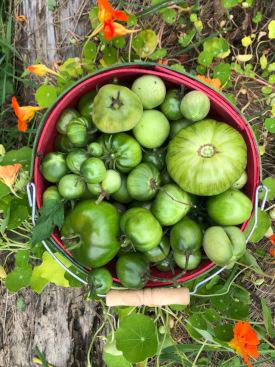
Green tomatoes are often abundant at the end of the summer season in the beginning of fall. A delicious way of preserving them is making green tomato chutney. (Photo: Courtesy of Bobby Bascomb)
BASCOMB: What types of foods do you think freeze really well?
McCLELLAN: I think that things like peaches you know, sliced up maybe mixed in with a little bit of sugar to help prevent freezer burn is a good way to go. You can also do individually quick frozen peaches like you get at the grocery store where you cut them into quarters and lay them out on a cookie sheet and freeze them like that and then funnel them into a plastic bag. I love to freeze pesto because there's no other good way to preserve it but it's such a delicious way to capture all of those herbs that happen in the garden at the end of the season. I've taken to making a plant-based pesto just to ensure that I have something that I could feed to anybody who comes my way so I do it with nutritional yeast and sunflower seeds as opposed to the traditional cheese and pine nuts and so then it's not free and it's dairy free and you know anybody can eat it. Other things that I like to freeze I will often freeze kale when that's in season and the way I do that best practice typically has you blanch your greens, but I find that they keep for several months if you just wash them, pull them off the stems and then cram them into Ziploc bags and freeze those and then what I do is I just pull out a handful of leaves when I want to make a pot of soup or something like that, chop them up or even just crumble them over the pot because it kind of crumbles frozen and then it's so easy and it's a you know, a almost work free way of putting up that kale or those greens.
BASCOMB: Okay, well I'm interested in that one I have always just a bumper crop of kale every year. It comes up on its own I don't even plant it anymore. And I have made kale soup kale fritters, kale chips, kale curry, I mean I think I've exhausted the ways to make kale to be honest with you, but I haven't tried just freezing it something simple as that.
McCLELLAN: It is game changing actually because you know it can be a lot of work to break down kale when it's fresh but when it's frozen, it just kind of breaks down on its own. It really can just kind of crumple it up. And so it's easy to use. I use it in like scrambled eggs skillets soup, pasta sauces, it's great.
BASCOMB: All right, I'm gonna give it a try. Now of course apples are in season right now. What are your favorite things to do with apples to preserve them?
McCLELLAN: There's nothing better than just plain old homemade applesauce. You can can it, you can freeze it. I also love to make apple butter and I do that in a slow cooker where I'll just keep in apples that have been cored and peeled, add a little water, cook them down until they're soft, zap it with an immersion blender right in the slow cooker and then continue to cook it down until all the waters cooked out. And then you can add some spices, lemon juice, a little sugar, maybe some maple syrup instead and either can it or put it in the refrigerator and just eat it. It's delicious.
BASCOMB: That sounds great. I have to say we have a few apple trees here and they all produce just a ton of apples this year. So I actually bought a cider press. I can't believe
McCLELLAN: Oh, wow.
BASCOMB: I know, I know, right? If you had told me a few years ago that I'd be a person with a cider press I don't know that I would believe you, but here we are. But you know, I have to say it's been really fun and also that's something you know, you can put in a jug and sort of forget about it for a few months and you come back and now you have hard cider, which is kind of fun.
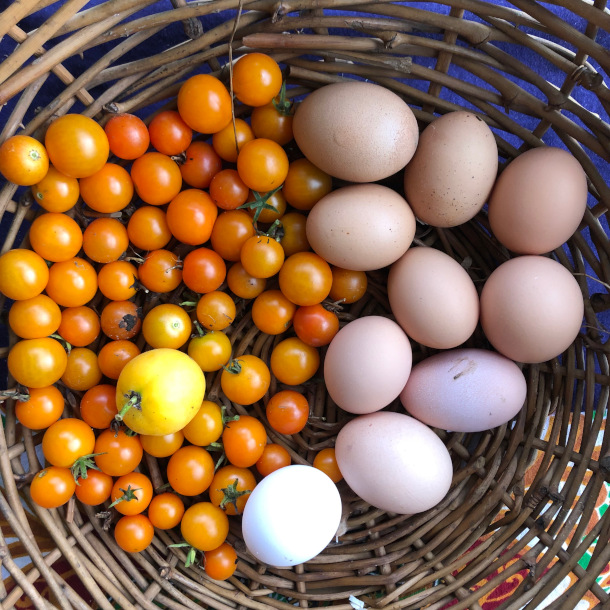
Tomatoes and eggs from Bobby Bascomb’s garden. (Photo: Courtesy of Bobby Bascomb)
McCLELLAN: Yeah, or leave it even longer and you'll have vinegar, perfect. Oh, I hadn't thought about that. Yeah, and if you have a bottle of store-bought vinegar that has a little bit of that mother on it, you know the culture that forms that little scum on the surface, you can pluck that out and put it into your apple juice, and it'll jumpstart the vinegar process, and it'll be even faster and better.
BASCOMB: Oh, wow. Now I've read that you can actually take the pulp that's left from making cider and use that to make apple cider vinegar. I haven't tried it yet, though.
McCLELLAN: Hmm, I guess you could do that. You could combine that with water and then yeah, that would work, definitely. You could also take that pulp and combine it with a little bit of sugar and cook it into sort of a paste. And then you'd have like an apple cheese, which is an old school fruit preservation method. Like you know how you get quince paste, it would be an apple paste like that.
BASCOMB: Apple, did you say cheese?
McCLELLAN: Yeah, that's the name for those fruit preserves that are cooked to the point where it's like a sliceable paste. It's often called the fruit cheese.
BASCOMB: Oh, I had no idea. No, idea. All right. Okay, well, you've given me a lot of ideas here. You know where I live, we still haven't had a frost. So I'm actually harvesting loads of tomatoes yet they're not looking so great I have to say, the vines, but the tomatoes are still producing. What do you like to do with those this time of year?
McCLELLAN: Tomatoes are my favorite thing to preserve this time of year and they are the gift that just keeps giving. I love to sauce them just you know, pulp them cook them down into sauce, and can that with a little bit of lemon juice or citric acid, you know that's you can never go wrong. I also make pizza sauce this time of year, which is really great one to have in the pantry. And I love to make tomato jam, that's another one that that's actually the most popular recipe I've ever published on my website. People have come back to me for years saying that that became their beloved family recipe too. And it's really just tomatoes and sugar and lime juice and a bunch of spices and you cook it down and it turns into something that is like ketchup, but is better than any ketchup you've ever had and it can go places that ketchup can't. So that's a really good one for your tomatoes. And it's great because you don't have to peel them like that's the beauty of that recipe is that you want the skins in it because it gives a texture.
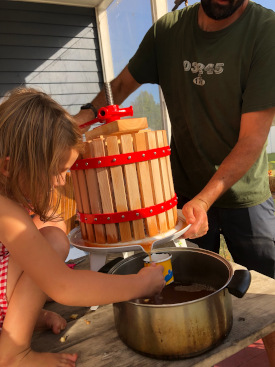
A cider press is a great way to crush apples and pears and create a delicious cider beverage. (Photo: Courtesy of Bobby Bascomb)
BASCOMB: What about roasting tomatoes or you know, even sun-dried tomatoes?
McCLELLAN: That is also a great way to go. I love to roast tomatoes low and slow. So you cut them in half, put them in a really low oven for like 10 to 14 hours and they kind of dry out. It becomes almost sun roasted and then it's just like this concentrated tomato nugget. And then you can either freeze them or you can puree them into sauces and you know, proceed with canning them that way, but they are delicious.
BASCOMB: Could you even put it in a jar with olive oil and garlic, that sort of thing and hold on to it until you need it?
McCLELLAN: That is actually not a great technique because it can cultivate botulism. So botulism is the thing we're scared of when it comes to canning. And tomatoes are not actually as acidic as we think they are and so if you need to have a high acid preserve, you need to often add acid to tomatoes to make them safe. And then if you add garlic, which is a low acid food to a tomato, and then you create an anaerobic environment with that olive oil, it can create something that's potentially deadly. So it's better if you're going to add garlic that you keep lots of oil out of it and then either freeze it or refrigerate it as opposed to canning it because you just want to be safe.
BASCOMB: No one wants botulism.
McCLELLAN: Nobody, nobody wants it.
BASCOMB: No indeed. What about green tomatoes?
McCLELLAN: Green tomatoes are fabulous and I know everybody has them who gardens this time of year. I love to turn them into chutney and chutney is such an easy preserve to make. There's no technique, there's no set point you're looking for you chop up the tomatoes, you put them in a pot with sugar, vinegar, onion, maybe some raisins or other dried fruit and spices and you just boil it down. You just keep cooking it until it's thick. Like that's it and you can do it slower and it'll take like two or three hours you could do a little bit faster if you have to monitor it, and it'll take maybe 90 minutes and then once it's thick once it's not looking at all watery, it's done. And you can water bath can it as long as you're following a recipe that was created with that acid balance in mind, or you can just put in the refrigerator and eat it up. But it's great particularly if you're planning ahead for the holidays, because it's great on a cheese board, it's great with the roasted turkey and roasted meats that we see a lot of times as we head into the holidays. It's also even great with latkes so it's a really good one for this time of year.
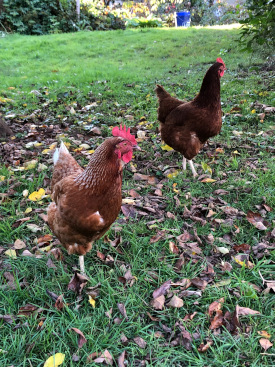
Apart from producing fresh eggs and acting as pest control, chickens are excellent at scratching through fall leaves and cutting them into pieces so they’re better absorbed by soil. (Photo: Courtesy of Bobby Bascomb)
BASCOMB: What about pickling produce? I know pickles aren't exclusive to cucumbers. What else do you like to pickle?
McCLELLAN: Well this time of year I love to pickle the last zucchinis they make a great pickle. Just you treat him like a cucumber, slice them up, and I like to make them as refrigerator pickles. I also love to do carrots this time of year you know just make carrot coins or carrot spears and do them in the same kind of dilled and garlic brine that I would do cucumbers in. Even the brussel sprouts is a really good candidate for pickling this time of year and they are better I find if you do them fresh because if you don't process them in a boiling water bath canner because then they're crispy and you don't get that kind of signature cabbage cooked cabbage stink that you would get. And so those are great cauliflower another one cauliflower makes a really great pickle. I like to do with a lot of lemon juice because that helps prevent the cauliflower from turning gray in the jar and cauliflower can turn a little gray, but the lemon juice helps keep it nice and bright and white.
BASCOMB: Well pretty soon of course Halloween will be here. Is there anything that we can do with those leftover jack o' lanterns when the holiday is past, I know they're not the best pumpkin for cooking usually because they're so big and a little bit more watery. They're not as sweet as we usually like pumpkins to be. But what can we do with them besides just throw them in the compost?
McCLELLAN: Well, if you've already carved it and it's been out for a few days, it might not be great to cook down but if it's still in good shape or you've got a pumpkin you were just using for decor and it wasn't carved up. Here's what I would do I would take it and I would roast it. You can either roasted whole if it's still intact or if you've got a jack o' lantern where you carved it that night and it's just out for Halloween and then you bring it back in. You can cut it up into pieces and roast it and then you know 300- or 350-degrees Fahrenheit roasted just till it's tender, then you scrape the flesh out of the skin. I also like to put those seeds aside and you can grab the seeds even if you've roasted the pumpkin and scoop them out separate the seeds from the stringy mess and then what I like to do with the seeds is boil them in some salted water then drain them and then roast them and by doing that you get the salt infuses the seeds and just makes them more flavorful. But then once you've got the pumpkin flesh you scrape it out of the skin and what I like to do is puree it and then drain it. So because those big pumpkins for Halloween those big jack o' lanterns can be very watery. And so you want to concentrate the flavor of the flesh and so you've already kind of concentrated the sweetness by roasting it and then you scrape it out and puree it in a blender or use an immersion blender and kind of zap it and then put it in a fine sieve and let the water drain out. And if you don't have a fine sieve you can line a colander with cheesecloth or even just a clean then kitchen towel and let the water drain out. And then what you have left is a very concentrated hopefully fairly thick pumpkin puree that you can pack into containers and freeze and then use in like pumpkin bread. You could use it as sort of like a pumpkin souffle. I also like to take those containers I tend to freeze it in two cup portions and stir it into risotto into the fall and winter that's delicious because you've got that kind of creamy rice you stir in the pumpkin it makes it really rich. So that's great. You can also cook it down into pumpkin butter which is delicious. I like to combine it with maple sugar and spices and a little bit of lemon juice and cook it down and cook it down. And then that's something that I keep in the fridge or I freeze. Pumpkin butter is too low in acid to be canned safely but it's still delicious just to have on hand.

Marisa McClellan is a food writer and creator of Food in Jars. (Photo: Courtesy of Marisa McClellan)
BASCOMB: And of course, pumpkin pie.
McCLELLAN: And of course, pumpkin pies. I feel like that, you know it's so obvious it goes without saying.
BASCOMB: Of course. Marisa McClellan is a cookbook author, a food writer and creator of Food in Jars. Marisa, thank you so much for taking this time with me today.
McCLELLAN: Thank you. It's really been a pleasure.
CURWOOD: Thanks, Bobby. Now I have some great ideas for what to do with all those pumpkins in front of my house.
BASCOMB: Yeah, me too. You know, I’m really not a fan of green tomatoes but I may have to try green tomato chutney.
CURWOOD: That sounds good, you cook, I’ll taste.
BASCOMB: Ok, as long as you clean up after!
Links
Learn more about Marisa McClellan and check out her recipes
Learn how to make apple paste, a.k.a. apple-quince fruit cheese
Living on Earth wants to hear from you!
Living on Earth
62 Calef Highway, Suite 212
Lee, NH 03861
Telephone: 617-287-4121
E-mail: comments@loe.org
Newsletter [Click here]
Donate to Living on Earth!
Living on Earth is an independent media program and relies entirely on contributions from listeners and institutions supporting public service. Please donate now to preserve an independent environmental voice.
NewsletterLiving on Earth offers a weekly delivery of the show's rundown to your mailbox. Sign up for our newsletter today!
 Sailors For The Sea: Be the change you want to sea.
Sailors For The Sea: Be the change you want to sea.
 The Grantham Foundation for the Protection of the Environment: Committed to protecting and improving the health of the global environment.
The Grantham Foundation for the Protection of the Environment: Committed to protecting and improving the health of the global environment.
 Contribute to Living on Earth and receive, as our gift to you, an archival print of one of Mark Seth Lender's extraordinary wildlife photographs. Follow the link to see Mark's current collection of photographs.
Contribute to Living on Earth and receive, as our gift to you, an archival print of one of Mark Seth Lender's extraordinary wildlife photographs. Follow the link to see Mark's current collection of photographs.
 Buy a signed copy of Mark Seth Lender's book Smeagull the Seagull & support Living on Earth
Buy a signed copy of Mark Seth Lender's book Smeagull the Seagull & support Living on Earth

